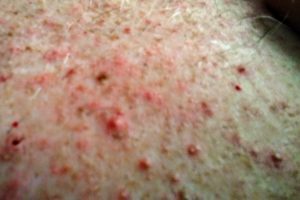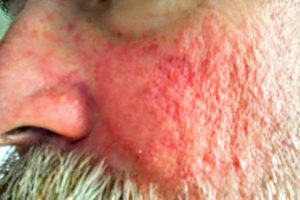Spoiler alert: my rash has returned.
Before I get into the details of this new leg of my journey, I’m taking a moment to reflect on the side-effects of the past. In August of last year (2017), I stopped taking chemotherapy due to signs of progression. After about a month of cleaning out my system, I noticed a serious boost in both my mental and physical energy levels. My body began shaping up. I felt really good. And I started my first “targeted” therapy, the drug Gilotrif (generic name, afatinib).
Gilotrif was highly promising at the time. It had shown some level of effectiveness on the HER2 mutation in cancer studies but was still off-label for my use because it was designed to target a very closely related mutation. I loved it at first, however, because I kept feeling better and — in comparison to my 2 years and 8 months on Alimta (generic name, pemetrexed) — there was just an amazing lack of initial side-effects. Alimta had been fairly easy to tolerate overall and I had no real complaints considering how well it had worked. But I did have some skin and digestive issues, as well as persistent fatigue, that plagued me every month. Toward the end, the skin issues were particularly bothersome, and I was beyond thrilled when they cleared up.
Gilotrif, a pill, is one of many targeted drugs that work on the Epidermal Growth Factor Receptors (EGFR) in some cancer cells. In breast cancers, the HER2 mutations are quite common, but they also show up in adenocarcinomas of the lung, like mine. And in the cases of lung cancer, they are often considered “driving” mutations, meaning that they are possibly more responsible for the actual growth of the cancer cells. Because they attack epidermal growth, however, they are prone to affecting the skin, nails, and possibly even the hair. It also caused some digestive issues, but those were much more moderate than anticipated.
It did not take long for Gilotrif to cause a rash that rivaled the worst of what I experienced under the influence of chemo. It was so irritating, actually, that I went to a dermatologist for help and ended up with a nice selection of ointments and creams which I have fortunately held onto. There was a decent amount of them leftover because, shortly after breaking down and dropping a load of cash on these prescriptions, I was pulled off that drug. Gilotrif, for as much as I loved the way I felt overall while taking it, had allowed a new metastasis to develop in my lower back, pressing right up against my sciatic nerve.
By the end of January, I was lined up for radiation treatment of my lower back and spine, which led to a host of really bad digestive problems for a couple of weeks, followed by a bad bout of the stomach flu. I was a bit of a mess throughout February, in spite of being off the big drugs.
That painful episode lasted long enough for me to get a first-hand understanding of the stigma that many cancer patients face regarding opioid use for pain management. And it was the beginning of a secondary appreciation of the stigma associated with opioid use for other reasons, too, because it was about that time I developed the persistent cough I am only now getting under control. It turns out that opioids are about the only consistently effective method I have had for keeping my cough under control, especially at night. But by way of lead-in to the cough issue, I will digress with the short-lived targeted therapy, Kadcyla (generic name, ado-trastuzumab emtansine) that we attempted as a replacement for Gilotrif. Kadcyla was administered as an infusion like my old chemotherapy, and as such I was concerned about getting more of the old chemo-like effects. Happily, there were none.
And by none, I mean that I really felt no side-effects to speak of. My energy levels rose even higher than they had been under Gilotrif. And my rash completely went away. It was awesome. But it didn’t work.
The good news was that, for a number of months already, I had been talking with my oncologist about getting into a clinical trial for Poziotinib. This new drug had been in development for long enough to know that it was safe and effective for the mutation that we were targeting. Plus, it was again going to be a pill I could take at home. Like the last two drugs, it works by attacking the epidermal growth factor receptors, but it is effective against a wider range of the mutations in that group. Many drugs have been applied to the EGFR mutation, and the HER2 mutation, but this one was designed to work with HER1, HER2, HER3, and HER4. What that meant for me was that my mutation, specifically the ErbB2 mutation that falls into the HER2 classification, was much more likely to be “discovered” by this drug than the earlier versions that worked on a much more narrow pathway. At least that was my hope.
Last week, I finally finished jumping through the hoops to qualify for the clinical trial and get things started. On May 23rd, after a series of blood draws and EKGs and another CT scan (I’m not even going into the weekend hospital stay due to my required biopsy), I took my first dose along with a little loperamide (the stuff in Imodium A-D) to slow the digestive process. I also began taking an anti-biotic, levofloxacin, to work on any infection that might be exacerbating my chronic cough. Six days into my new treatment, the good news is that the cough is a fraction of the irritation that it had been over the past four months. It is still there, and it is still highly reactive, but it no longer has the force or persistence that it did a week ago. I can feel a huge difference overall.

The bad news, and I suppose I need to keep that in relative perspective, is that the rash has returned. And it is back with a vengance, really cropping up in the last two days as visibly as the worst of my Gilotrif-induced skin irritation. My scalp is itching like crazy, especially at night, and I’m blotchy and itchy all over my upper torso. I’m not thrilled, of course, but on the other hand, at least I know that the drug is truly in my system. And, as I stated earlier, I have a lot of the prescription goodies left from my dermatologist to try right off the bat. With a bit of luck, I’ll be able to clear much of my skin up quickly while my body begins to adjust to the new “friend” I have in my system.
Now, I just need to sit back and see what else arises. I’m totally willing to handle a few more side-effects — as long as this new drug is working. In about three weeks, another CT scan will give us some good indication of whether my body is responding to this treatment. In the meantime, I’m just glad to be getting some really deep breaths in without worrying about coughing them right back out again.


Keep breathing friend! Many paraders and good energy from this direction accompany every breath!
Thank you so much! The inhaling sure feels good.
You continue to amaze me with your positive attitude. I pray that this drug will be the answer for you. As I draw close to my next CT scan – I get very worried…but I think of you and know that I can do it. Thanks for being you Jeff.
Don’t forget to keep me posted on your CT results. I’ll be thinking of you — just remember, it’s all part of the process. Stay well!
OUCH! Looks nasty.. Cancer and its grumbling little side kicks can fuck off. Hope the spine is feeling more comfortable. No wise words from this dame, other than, keep kicking. Sending a big English smile all the way from Australia. X
Lizz, I hope that you are getting good news over on your ever-so-distant continent.
My spine is feeling much better — in fact, skin aside, I am feeling pretty good these days. It would be better with some sleep, but that will come back eventually. But if you think this looks nasty…well…I’m preparing a follow up with more pics. 😉
Take care! And glad to hear from you.